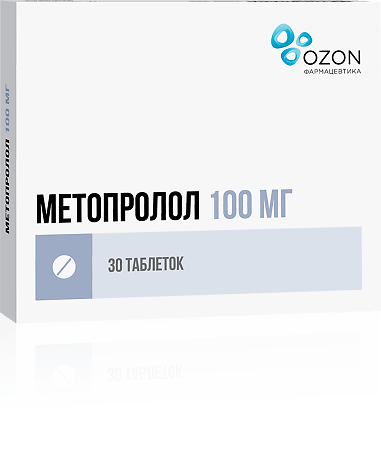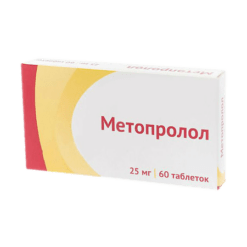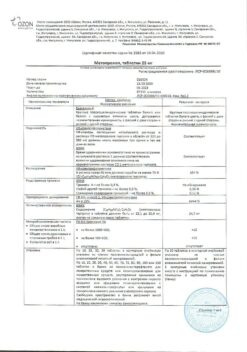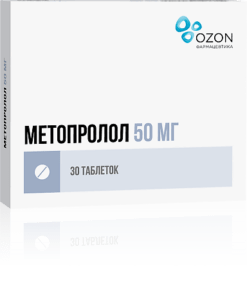No products in the cart.
Metoprolol, tablets 100 mg 30 pcs
€2.64 €2.00
Description
A cardioselective beta1-adrenoblocker without intrinsic sympathomimetic activity. It has hypotensive, antianginal and antiarrhythmic effects. It reduces automatism of the sinus node, decreases heart rate, slows AV conduction, reduces myocardial contractility and excitability, decreases cardiac output, and decreases myocardial oxygen demand.
Suppresses the stimulating effect of catecholamines on the heart during physical and psycho-emotional stress.
Causes a hypotensive effect, which stabilizes by the end of the 2nd week of course use. In tension angina metoprolol reduces the frequency and severity of attacks. It normalizes the heart rhythm in supraventricular tachycardia and atrial fibrillation.
In myocardial infarction helps to limit the zone of ischemia of the heart muscle and reduces the risk of fatal arrhythmias, reduces the possibility of recurrent myocardial infarction. When used in medium therapeutic doses, it has less pronounced effect on the smooth muscle of the bronchi and peripheral arteries than non-selective beta-adrenoblockers.
.
Indications
Indications
Arterial hypertension (monotherapy or in combination with other antihypertensive drugs), coronary artery disease, functional disorders of cardiac activity accompanied by tachycardia, myocardial infarction, prevention of angina attacks, heart rhythm disturbances, hyperthyroidism (complex therapy), prevention of migraine attacks.
Pharmacological effect
Pharmacological effect
Cardioselective beta1-blocker without intrinsic sympathomimetic activity. It has hypotensive, antianginal and antiarrhythmic effects. Reduces the automaticity of the sinus node, reduces heart rate, slows AV conduction, reduces myocardial contractility and excitability, reduces cardiac output, and reduces myocardial oxygen demand.
Suppresses the stimulating effect of catecholamines on the heart during physical and psycho-emotional stress.
Causes a hypotensive effect, which stabilizes by the end of the 2nd week of course use. For angina pectoris, metoprolol reduces the frequency and severity of attacks. Normalizes heart rate during supraventricular tachycardia and atrial fibrillation.
In case of myocardial infarction, it helps to limit the ischemia zone of the heart muscle and reduces the risk of developing fatal arrhythmias, and reduces the possibility of relapses of myocardial infarction. When used in average therapeutic doses, it has a less pronounced effect on the smooth muscles of the bronchi and peripheral arteries than non-selective beta-blockers.
Special instructions
Special instructions
Use with caution in patients with chronic obstructive respiratory diseases, diabetes mellitus (especially with a labile course), Raynaud’s disease and obliterating diseases of the peripheral arteries, pheochromocytoma (should be used in combination with alpha-blockers), severe renal and liver dysfunction.
During treatment with metoprolol, there may be a decrease in the production of tear fluid, which is important for patients who use contact lenses.
Completion of a long course of treatment with metoprolol should be carried out gradually (over a minimum of 10 days) under the supervision of a physician.
Concomitant use of metoprolol with MAO inhibitors is not recommended.
In combination therapy with clonidine, the latter should be discontinued several days after metoprolol is discontinued in order to avoid a hypertensive crisis. When used simultaneously with hypoglycemic agents, correction of their dosage regimen is required.
A few days before anesthesia, it is necessary to stop taking metoprolol or select an anesthetic agent with minimal negative inotropic effect.
Impact on the ability to drive vehicles and operate machinery
In patients whose activities require increased attention, the issue of using metoprolol on an outpatient basis should be decided only after assessing the patient’s individual response.
Active ingredient
Active ingredient
Metoprolol
Composition
Composition
1 tab. contains:
Active substances:
metoprolol100 mg
Excipients:
lactose monohydrate 180 mg,
microcrystalline cellulose 72 mg,
potato starch 12 mg,
sodium carboxymethyl starch 16 mg,
povidone 16 mg,
magnesium stearate 4 mg.
Contraindications
Contraindications
Hypersensitivity, cardiogenic shock, AV block II and III degrees, sinoatrial block, chronic (in the stage of decompensation) heart failure, sick sinus syndrome, severe sinus bradycardia (heart rate less than 60 beats/min), Prinzmetal’s angina, acute myocardial infarction (heart rate less than 45 beats, PQ interval more than 0.24 sec, systolic blood pressure less than 100 mm Hg).
Pregnancy, lactation period. Simultaneous intravenous administration of “slow” calcium channel blockers such as verapamil. Age up to 18 years. Pheochromocytoma. patients receiving long-term or intermittent therapy with inotropic agents acting on beta-adrenergic receptors.
Side Effects
Side Effects
From the cardiovascular system: bradycardia, arterial hypotension, AV conduction disturbances, and symptoms of heart failure are possible.
From the digestive system: at the beginning of therapy, dry mouth, nausea, vomiting, diarrhea, constipation are possible; in some cases – liver dysfunction.
From the central nervous system and peripheral nervous system: at the beginning of therapy, weakness, fatigue, dizziness, headache, muscle cramps, feeling of cold and paresthesia in the extremities are possible; possible decrease in the secretion of tear fluid, conjunctivitis, rhinitis, depression, sleep disturbances, nightmares.
From the hematopoietic system: in some cases – thrombocytopenia.
From the endocrine system: hypoglycemic conditions in patients with diabetes mellitus.
From the respiratory system: in predisposed patients, symptoms of bronchial obstruction may appear.
Allergic reactions: skin rash, itching.
Interaction
Interaction
When used simultaneously with antihypertensive drugs, diuretics, antiarrhythmic drugs, nitrates, there is a risk of developing severe arterial hypotension, bradycardia, and AV block.
When used simultaneously with barbiturates, the metabolism of metoprolol is accelerated, which leads to a decrease in its effectiveness.
When used simultaneously with hypoglycemic agents, the effect of hypoglycemic agents may be enhanced.
When used simultaneously with NSAIDs, the hypotensive effect of metoprolol may be reduced.
When used simultaneously with opioid analgesics, the cardiodepressive effect is mutually enhanced.
When used simultaneously with peripheral muscle relaxants, neuromuscular blockade may be enhanced.
When used simultaneously with drugs for inhalation anesthesia, the risk of suppression of myocardial function and the development of arterial hypotension increases.
When used simultaneously with oral contraceptives, hydralazine, ranitidine, cimetidine, the concentration of metoprolol in the blood plasma increases.
When used simultaneously with amiodarone, arterial hypotension, bradycardia, ventricular fibrillation, and asystole are possible.
When used simultaneously with verapamil, the plasma Cmax and AUC of metoprolol increases. The minute and stroke volume of the heart, pulse rate, and arterial hypotension decrease. Possible development of heart failure, dyspnea and sinus node block.
With intravenous administration of verapamil while taking metoprolol, there is a risk of cardiac arrest.
With simultaneous use, bradycardia caused by digitalis glycosides may increase.
When used simultaneously with dextropropoxyphene, the bioavailability of metoprolol increases.
When used concomitantly with diazepam, a decrease in clearance and an increase in the AUC of diazepam is possible, which can lead to an increase in its effects and a decrease in the speed of psychomotor reactions.
When used simultaneously with diltiazem, the concentration of metoprolol in the blood plasma increases due to inhibition of its metabolism under the influence of diltiazem. The effect on cardiac activity is additively inhibited due to the slowing of impulse transmission through the AV node caused by diltiazem. There is a risk of developing severe bradycardia, a significant decrease in stroke and minute volume.
When used simultaneously with lidocaine, the elimination of lidocaine may be impaired.
When used simultaneously with mibefradil in patients with low activity of the CYP2D6 isoenzyme, it is possible to increase the concentration of metoprolol in the blood plasma and increase the risk of developing toxic effects.
When used simultaneously with norepinephrine, epinephrine, other adrenergic and sympathomimetics (including in the form of eye drops or as part of antitussives), a slight increase in blood pressure is possible.
When used simultaneously with propafenone, the concentration of metoprolol in the blood plasma increases and a toxic effect develops. It is believed that propafenone inhibits the metabolism of metoprolol in the liver, reducing its clearance and increasing serum concentrations.
When used simultaneously with reserpine, guanfacine, methyldopa, clonidine, severe bradycardia may develop.
When used simultaneously with rifampicin, the concentration of metoprolol in the blood plasma decreases.
Metoprolol may cause a slight decrease in the clearance of theophylline in patients who smoke.
Fluoxetine inhibits the CYP2D6 isoenzyme, which leads to inhibition of metoprolol metabolism and its accumulation, which can enhance the cardiodepressive effect and cause bradycardia. A case of lethargy development is described.
Fluoxetine and mainly its metabolites are characterized by a long T1/2, so the likelihood of drug interactions remains even several days after fluoxetine is discontinued.
There are reports of a decrease in the clearance of metoprolol from the body when used simultaneously with ciprofloxacin.
When used simultaneously with ergotamine, peripheral circulatory disorders may increase.
When used simultaneously with estrogens, the antihypertensive effect of metoprolol is reduced.
With simultaneous use, metoprolol increases the concentration of ethanol in the blood and prolongs its elimination.
Overdose
Overdose
Symptoms: severe sinus bradycardia, dizziness, AV block (up to the development of complete transverse block and cardiac arrest), marked decrease in blood pressure, fainting, arrhythmia/ventricular extrasystole, acute heart failure; cardiogenic shock, cardiac arrest, bronchospasm, loss of consciousness, coma, nausea, vomiting, cyanosis, hypoglycemia, convulsions. The first signs of overdose appear 20 minutes -2 hours after taking the drug.
Treatment: gastric lavage and administration of adsorbent drugs, symptomatic therapy: with a pronounced decrease in blood pressure, the patient should be in the Trendelenburg position; in case of excessive decrease in blood pressure, bradycardia and heart failure – intravenous administration of beta-adrenergic stimulants at intervals of 2-5 minutes until the desired effect is achieved or intravenous administration of 0.5-2 mg of atropine sulfate. If there is no positive effect, dopamine, dobutamine or norepinephrine. As a follow-up measure, it is possible to install a transvenous intracardial pacemaker. For bronchospasm, beta-agonists should be administered intravenously. For convulsions – slow intravenous administration of diazepam. Hemodialysis is ineffective.
Storage conditions
Storage conditions
In a place protected from light, at a temperature not exceeding 25°C.
Shelf life
Shelf life
See packaging.
Manufacturer
Manufacturer
Ozon, Russia
Additional information
| Shelf life | See on the package. |
|---|---|
| Conditions of storage | In a place protected from light, at a temperature not exceeding 25°C. |
| Manufacturer | Ozon, Russia |
| Medication form | pills |
| Brand | Ozon |
Other forms…
Related products
Buy Metoprolol, tablets 100 mg 30 pcs with delivery to USA, UK, Europe and over 120 other countries.

















